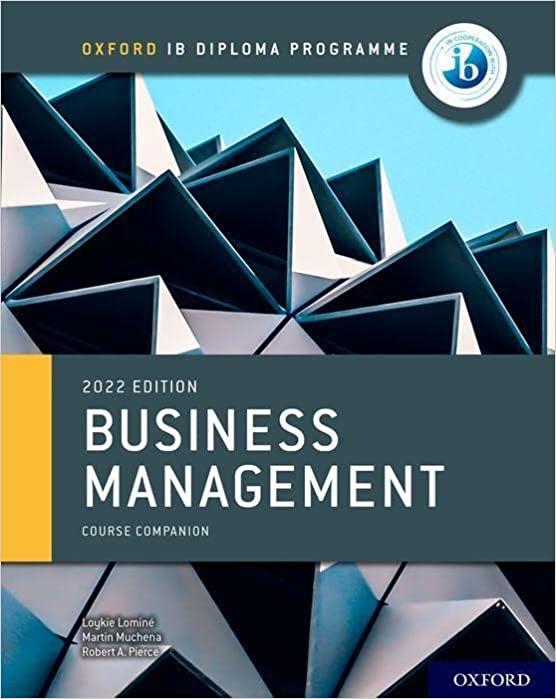Question
Please help me wit the following assignment: Reengineering Phantom: How Will You ManageaChange? CEO Marina Delatorre was in trouble with the Board of Directors for
Please help me wit the following assignment:
Reengineering Phantom: How Will You ManageaChange?
CEO Marina Delatorre was in trouble with the Board of Directors for her reluctance to move quickly in reengineering Phantom Savings and Loan. The company's stock was selling far below its true value, according to board members, because Delatorre had not demonstrated her willingness to implement a reengineering effort that would recalibrate all the bank's processes for enhanced productivity. The board suspected that Delatorre was dragging her feet because of an aversion to laying off employees. The company's president, Eugene Trascher, had no such wariness. He had brought in a team of consultants from the well- regarded TACK firm to help him achieve his goal of a 20% reduction in operating expenses. TACK had already completed much of the study. Instead of examining the company by division, department, or function, it had divided the company into core processes, such as customer operations, customer support, and customer contact. Then it made direct process observations. TACK also sent consultants and company personnel to visit other companies that had lowered their costs. Lessons from these visits were molded into the final recommendations. Some of the findings were appalling; for example, Phantom bought many different brands of computers each year.
The consultants now wanted to proceed beyond the first-phase diagnostics to broad-scale implementation. They had written the script for the reengineering exercise and wanted to continue guiding the effort. They talked of finding the optimal solutions for crafting new process platforms and engaging in phase-out diagnostics. TACK produced a thick book of 350 changes it wanted to make, from consolidating work centers to simplifying procedures for approving customer service. TACK said that if its fixes were implemented they would generate a high internal rate of return and a payback on investment in 2 years. If the consulting achieved only one quarter of its goals, the company still would see a 3-year payback. Board members enthusiastically received these numbers.
When questioned about the human side of the layoffs, one of the TACK consultants replied that employees would be retrained with survival skills related to initiative, teamwork, accountability, and open communications. They would need these "whether they stayed at Phantom or ended up somewhere else." In the year the restructuring was considered, Phantom had $151 million in losses compared with a profit of $356 million the previous year. Phantom had a large multistate branch network and employed 26,432 people; TACK sought to cut up to 7,000 employees from the payroll. Phantom said the details of the buyout packages would be announced shortly. If enough people did not voluntarily accept the packages, the company would have to let them go.
Delatorre thought that TACK's plan was probably necessary. After previous cutbacks, 160 employees had banded together to bring a class-action suit against Phantom for age discrimination. Delatorre asked the HR to determine how many of the laid-off employees had new jobs. After 3 years, more than half were still unemployed. When she addressed the various concerns she had to Trascher, he replied, "If we don't lay off these people, our losses will only mount, and the longer we delay, the worse it will be." Delatorre wondered about the commitment and loyalty of the remaining employees if the layoffs were carried out. It is evident that a radical organizational change is underway. The successful implementation of TACK's plan, which has the potential to save the company, highly depends upon the commitment and engagement of the remaining employees.
Place yourself in Delatorre's position. Considering the above dynamics, devise a "high-level" phased plan to manage the key dimensions of the upcoming change. Your primary objective will be to facilitate the successful implementation of TACK's plan by preparing the remaining workforce both mentally and operationally. Your proposed plan should be consistent with a well-established change management model. In addition, justify your proposed plan in terms of its effectiveness. As part of your justification, draw from relevant ethics concepts discussed in this course (e.g., deontology and consequentialism) to demonstrate that your decision/plan for managing the change is ethical. It is important to take into account the current psychological status, mental models, and perceptions of the remaining employees towards the organization with respect to all the events that they have been exposed to in recent years.
Please include 8 sources referenced and cited.
Required Resource
Middlebrooks, A., Allen, S.J., McNutt, M.S., Morrison, J.L.,Discovering Leadership: Designing Your Success
Step by Step Solution
There are 3 Steps involved in it
Step: 1

Get Instant Access to Expert-Tailored Solutions
See step-by-step solutions with expert insights and AI powered tools for academic success
Step: 2

Step: 3

Ace Your Homework with AI
Get the answers you need in no time with our AI-driven, step-by-step assistance
Get Started


